Tim Bavington
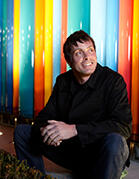
London-born, Las Vegas-based artist Tim Bavington received his BFA from the Art Center (CA) before making the permanent move to Las Vegas, where he completed his MFA at the University of Nevada, Las Vegas. Music is the genesis of Tim Bavington’s paintings. He is best known for translating music to canvas by assigning sounds to corresponding colors and compositions. His paintings are reminiscent of Op Art from the 1960s, yet possess the synthetic, digital glow of modern times. In his paintings, Bavington aligns the 12 notes of a musical scale with 12 tones of color from the color wheel. Using synthetic polymer paint, he translates audio—guitar music from The Rolling Stones, Jimi Hendrix, and Oasis—into vertical stripes of color that directly correspond to each note. Although his process adheres to a regimen, his paintings remain improvisational and rely on the decisions of his artistic presence. In addition to paintings, Bavington has explored large-scale sculptures, including an installation of musical energy translated to vertical bands of colored steel for The Smith Center for the Performing Arts.

Bavington's work is included in the public collections of Fredrick R. Weisman Collection (CA), Honolulu Art Museum (HI), Albright-Knox Art Gallery (NY), Creative Artists Agency (CA), Joslyn Art Museum (NE), Museum of Contemporary Art, San Diego (CA), Portland Art Museum (OR), United Talent Agency (CA), Vivendi Universal (CA), Palm Springs Art Museum (CA), Denver Art Museum (CO), The Museum of Modern Art (NY), and Nora Eccles Harrison Museum of Art, Utah State University (UT). He has exhibited at LeeAhn Gallery (Daegu), Jack Shainman Gallery (NY), Galerie Jean-Luc & Takako Richard (Paris), Space Gallery (London), Museum of Fine Arts (MA), Laguna Art Museum (CA), and the Texas Fine Arts Center (TX) among others.
Bavington was also awarded a GSA Art in Architecture Award for a large-scale installation in the Edith Green-Wendell Wyatt Federal Building in Portland, OR.
Sue Kim
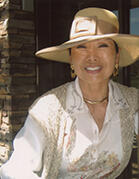
Sue Kim was a member of the popular singing group The Kim Sisters, a South Korean female trio who made their career in the United States during the 1950s and 1960s. The group included Sue (Sook-ja), Aija (Ai-ja) and Min (Minja) Kim.
She was born in Seoul, South Korean and started singing with her sisters at the age of ten. She played 13 different instruments, sang and danced.
The sisters arrived in Las Vegas in 1959 and appeared in the China Doll Revue at the Thunderbird Hotel. After fulfilling their contract at the Thunderbird, the entertainment director for the Stardust Hotel picked up their option, which started her journey of "4 weeks with a 4-week option". In 1959, while Ed Sullivan was broadcasting live from the Stardust he asked The Kim Sisters to appear on the show. They were such a big hit that he invited their mother and the Kim brothers to sing on his show in New York. Afterwards, he offered them an exclusive 22-show contract.
The Kim family made their home in Las Vegas where they were accepted by the Las Vegas audiences and the local media. This led them to a 15-year engagement at the Stardust, followed by 5 years at the Las Vegas Hilton and then 15 years at the Holiday Casino where Sue Kim and her brothers were the starring act.
When not performing in Las Vegas, they traveled all around the world and appeared on major television shows: The Dean Martin Variety Show, The Dinah Shore Show, Hollywood Palace, Operation Entertainment, The Steve Allen Show, The Joey Bishop Show, and The Merv Griffin Show. While appearing in Las Vegas The Kim Sisters co-starred with Maurice Chevalier, Louis Armstrong, George Burns, Jack Benny, Don Rickles, Helen Reddy, Phyllis Diller, Tony Martin, Phil Harris, Don Adams, Bob Newhart, Dick Shawn, Ames Brothers, Victor Borge, George Kirby, Jayne Mansfield, Diana Dors, and Martin Denny.

They appeared on many local charity shows such as the Jerry Lewis Telethon, the Shade tree Shelter Fundraiser, St. Viator Fundraiser, St. Jude, as well as other charities around the U.S. and all over Korea.
Sue Kim was named the president of the Korean American Women’s Association, and was given the Asian Community Achievement Award from the Las Vegas Chamber of Commerce for her work.
Las Vegas was so good to The Kim Sisters that they decided to become U.S. citizens in 1968. Sue Kim currently resides in Las Vegas with her husband of 45 years, John Boni; her son and his wife, Anthony and Marianne; and her daughter Marisa. She has five grandchildren. She has had a wonderful journey, which enabled her to bring her entire family from Korea to Las Vegas. She would like to thank the people of Las Vegas for giving her a great "4 weeks with a 4-week option."
Joe Williams
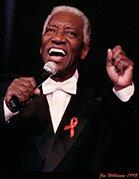
Joe Williams, well-known baritone jazz vocalist, grew up in Chicago, a city that offered a host of radio stations featuring jazz music, and exposing Williams to the stylings of Duke Ellington, Ethel Waters, Cab Calloway, Big Joe Turner, and many others.
During his mid-teens, Williams began performing as a vocalist, singing solo at formal events with local bands. In 1937, he was invited to sing with clarinet and saxophone player Jimmie Noone and his band, and less than a year later, he was earning a reputation at Chicago dance halls and on a national radio station that broadcast his voice from coast to coast. From 1939 to 1940, Williams toured with the Les Hite band, which accompanied the likes of Louis Armstrong and Fats Waller.
Williams got his big break in 1954, when he was hired as the male vocalist for the Count Basie Orchestra where he remained performing until 1961. Williams’ first LP, "Count Basie Swings, Joe Williams Sings," appeared in 1955 and contained definitive versions of Memphis Slim's "Every Day I Have the Blues" (already his signature song, and first recorded by him in 1952 on Checker Records) and "Alright, Okay, You Win." In 1955, Williams won DownBeat Magazine's New Star Award and that same year, he won DownBeat's international critics' poll for Best New Male Singer, as well as their readers' poll for Best Male Band Singer. From 1956-1959 he toured Europe, where the popularity of jazz had skyrocketed.
During the 1960s Williams worked mostly as a single, often accompanied by top-flight jazzmen, including Harry Edison, Clark Terry, George Shearing and Cannonball Adderley. He became a familiar face on television, appearing on such variety programs as Johnny Carson's "The Tonight Show," Steve Allen, Joey Bishop, Merv Griffin, and Mike Douglas shows. Williams gained further notoriety when Bill Cosby cast him as Heathcliff Huxtable's father-in-law "Grandpa Al" Hanks in a recurring role on the hit 1980s sitcom "The Cosby Show."
Williams continued to perform regularly at jazz festivals, both in the U.S. and abroad, as well as on the nightclub circuit. He performed at the legendary Monterey Jazz Festival 12 times, spanning from 1959-1993, sharing the stage with jazz greats such as Sarah Vaughan, Nancy Wilson, Dianne Reeves, Thelonious Monk, Oscar Peterson, Miles Davis, Cal Tjader, Carmen McRae, Herbie Hancock, Nat Adderley, and Dizzy Gillespie.

He was given a star on the Hollywood Walk of Fame in 1983. In 1985, Williams received a Grammy Award for Best Jazz Vocalist for "Nothin’ but the Blues." In 1991, he attended his own gala tribute, "For the Love of Joe," which celebrated his contribution to music.
Williams enjoyed a successful career and worked regularly until his death, at age 80, on March 29, 1999, in Las Vegas. Prior to his passing, Joe Williams, with his wife Jillean, John Levy, Williams' manager for most of his career, and his attorney created the non-profit Joe Williams Every Day Foundation. Its aim is to provide support for music and musicians, especially those in jazz, and to create career opportunities for deserving young talent. The Joe Williams Every Day Foundation Scholarships provide UNLV Jazz students with financial assistance for the academic year.
June T. Brennan

This year's Dean's Medal is awarded to June T. Brennan.
June Brennan has been a stalwart supporter of the Arts at UNLV for many years. She endowed a scholarship for students in theatre to honor her late husband James Brennan; she serves on the College of Fine Arts Advisory Board, a position she has held for many years; and she supports the college's excursions to Australia where UNLV students in jazz, percussion, theatre, dance, film, architecture, and art travel to perform at the Adelaide Fringe Festival. A true "cheerleader" for the Arts, she once traveled to Australia with the students to provide moral and financial support.
What truly stands out is June’s patronage of all the Arts. She regularly attends opening nights and receptions presented by all units of the college. She takes special joy in UNLV and is constantly expounding its virtues and stating how proud she is of "Our University!" She provides generously of her time, resources, and excellent advice to assist the college as it moves forward. Preferring to be behind the scenes, her wisdom and vision have assisted the College of Fine Arts in reaching its vision.

June was born in New York, NY and graduated with a BA in Arts and Sciences from the Catholic University in Washington D.C. During her career, she worked in fashion as a model, performed in theater, was a spokesperson (she was the first woman narrator for national car shows in New York and Chicago), was the first woman to appear as a newscaster in Las Vegas, and was a news director and disc jockey for a local radio station.
Married 43 years to James Brennan (deceased), they have five children and 11 grandchildren. June has been a Nevada resident since 1968 and is active with volunteer work for Assistance League of Las Vegas, Hospital Auxiliary Service at Southern Nevada Hospital and St. Rose de Lima, and is a scripture reader at Guardian Angel Shrine, Shrine of the Holy Redeemer, and Our Lady of Las Vegas churches. She also participates in the Masters Swimming Program.
Ronnie Vannucci '11
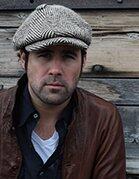
Vannucci was born in Las Vegas and began drumming at an early age. He continued to perform from the age of six. He was a part of his junior high school jazz ensemble and later attended both Clark and Western High Schools. After forming various locally popular bands, he decided to study percussion at UNLV.
Vannucci was working as a photographer at Chapel of the Flowers, a wedding chapel on the Las Vegas Strip, and at the same time was playing with the ska band Attaboy Skip. In August 2002, he joined Dave Keuning and Brandon Flowers who had recently begun performing as The Killers. They would practice at Vannucci’s garage, and then in the UNLV band room after hours in 2002 and 2003.
Vannucci completed most of his music studies at UNLV prior to 2003 in the area of Music Education with aspirations of teaching elementary school music in Las Vegas. In 2003, The Killers were signed by a major record label and started a quick ascent to superstardom in the rock and popular music world.
Since 2003, Vannucci has toured the world many time over, released several platinum selling records in more than 50 countries, appeared in TV shows and movies, been on the front cover of magazines, and has become one of the innovative icons of the drumming world. During this time, Vannucci maintained his connection and collaboration with UNLV, and later finalized his B.A. at UNLV on May 14, 2011 while The Killers were on hiatus.
On May 2, 2003, he married his wife Lisa with whom he lives in Las Vegas and Park City, Utah.
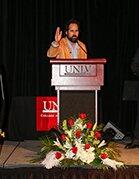
Vannucci helps to write The Killers hit songs (including "When You Were Young," "Believe Me Natalie," "Spaceman," "Bones," "Miss Atomic Bomb," "A Dustland Fairytale," "Human," "Somebody Told Me," and "On Top").
Vannucci was featured on the cover of Drummer Magazine in June 2009 and on the cover of Rhythm Magazine in October 2006 (where he was dubbed "pop's dymanic showman") and again in November 2008. He was featured in Modern Drummer Magazine in March 2009, and in Drumhead Magazine in September and again in October 2008. He was also featured on the cover of Rhythm Magazine in October 2012 and on the cover of Modern Drummer Magazine in February 2013.